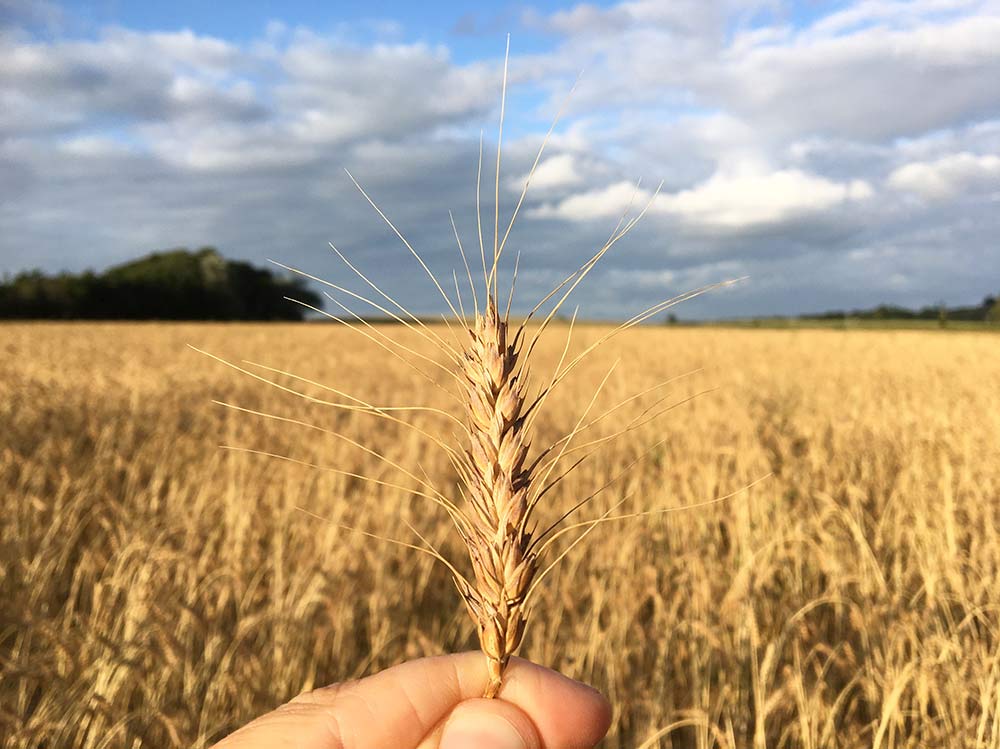It’s a sunny summer’s evening in the middle of August and a group of farmers, millers and bakers are standing amid a golden field of wheat in the heart of Somerset.
But this is not just any wheat, it’s a field of April Bearded wheat: commonly grown in the UK from the mid 19th Century until the 1950s, the grains are surrounded by a ‘beard’, or awn, that stretches from the ears in long spikes. Over the next few months, this grain will be combined, cleaned, transported, milled and baked into loaves of bread by the people standing in this field.
This face to face gathering of people along the supply chain is in stark contrast with the conventional commodity grain market, where everything is handled by a middleman.
Farmers normally sell their grain to these traders, often choosing to sell forwards and fix prices for future harvests in a way that is reminiscent of the stock market. This grain is then sold by traders into local, national and international markets.
They have no control about where their grain ends up – it may be headed to a port for export, or a feed mill 10 miles down the road – with just over half of British wheat destined for animal feed. Equally problematic is the type of wheat grown. Most farmers grow from a limited selection of high yielding hybridised varieties, a far cry from the ‘landraces’ of the past – genetically diverse populations of wheat created from generations of natural selection and seed saving.

The higher yields of monocultures and the pressure to make farming commercially viable has driven this change – but there is a growing interest in alternative models.
Fred Price from Gothelney Farm is the farmer behind this field of April Bearded wheat, switching from commodity to heritage grains about five years ago.
“When you’re producing a commodity crop, you have no control over the price other than trying to grow more and bring your cost of production per tonne down,” he explains. “But heritage grains are suited to low input systems; you don’t grow them for yield as they’re a valuable product that people want to put their pound behind.”
Finding the seed wasn’t easy though. Starting out with a mere five grams of seeds from a gene bank, each year Price carefully harvested the seed until he reached the 11 acres he has today. This field is only the tip of his experimentation – he’s got two test areas on the farm where he’s tried out more than 60 varieties from across the world, each year selecting the best to scale up.
Through the UK Grain Lab, Price found the market for his grain; a group of artisan bakers, including Owen Postgate, who owns the Rye Bakery in Frome. “Provenance is important with all the ingredients I use in my bakery and I like to be transparent about where they come from, why should the grain we use be any different?” says Postgate.
With the bakers on board, the final step was finding a supportive local miller, in the form of fifth-generation miller Michael Stoate. And so the South West Grain Network was born, with the first flour from wheat grown by Price reaching the bakers this autumn.

On the Welsh coast in Pembrokeshire, farmer and baker Rupert Dunn has chosen to close the loop himself.
He started experimenting with growing grains, based on a population wheat he was given on a trip to France, slowly scaling up to the 17 acres he’s just harvested.
“Originally there were over 100 wheats in the population, but it’s evolved every year in the field; it’s allowing nature to be in the driving seat of the evolutionary process.”
Dunn set up a Community Benefit Society called Torth-y-Tir, based on the idea of peasant bakeries in France. He mills the grains himself, using the flour in the bread and pizza he makes and sells locally through a membership model. “We’re community owned, so we’re connected with our customers,” he adds.
Connecting consumers and the grain system is at the heart of the Our Field project in Hertfordshire, where a group of 40 people decided they wanted to be more engaged in how grain is grown and sold, co-investing in a 28-acre field of wheat.
The group, with advice from the farmer, make all the decisions about what to grow, how to farm it and what to do with the grain once it is harvested. The crops chosen have been varied – the first year was spelt, last year was about fertility building, and this year there are a variety of crops including heritage wheat. “I hadn’t really engaged with the grain system before this project,” Abby Rose, one of the founders, explains. “I’d always go for buying organic veg but wouldn’t think twice about buying non-organic flour. But now I know, and I only buy top quality flour.”
With growing research as to the health and environmental benefits of heritage grains, there is a growing body of evidence to support the growing and eating of these grains.
Whether these models are driven by a group of individuals, a community network or one passionate person, diverse and local supply chains for bread will help bring about this change.












Great article
Agree, great article. What a relief to hear that these farmers are rescuing the old varieties [and thanks to the gene banks for making it possible]. Has anyone looked into whether any of these are digestible to people who have intolerance to modern wheat flours? Doesn’t affect me but does many people.
Denby
Great article. If you haven’t read the story of Organic YQ flour first developed by Martin Wolfe on his agroforestry farm Wakelyns, Suffolk, you’ll find the following Guardian article very interesting reading.
https://www.theguardian.com/food/2019/oct/10/flour-power-meet-the-bread-heads-baking-a-better-loaf